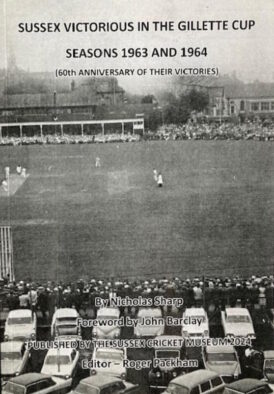Sussex Victorious in the Gillette Cup Seasons 1963 and 1964
Martin Chandler |Published: 2024
Pages: 52
Author: Sharp, Nicholas
Publisher: Sussex Cricket Museum
Rating: 3.5 stars

It is a sobering thought that the complete history of limited overs cricket at the top level of the game is contained within my lifetime, and I draw only limited comfort from the fact that extreme youth robs me of any sort of memory of its first few years. So I have some understanding of how Nicholas Sharp must feel, but there is no getting away from the fact that he has vivid memories of it all, and his presence at the first two Gillette Cup finals adds authority and authenticity to the latest publication to appear from the Sussex Cricket Museum.
That Sussex won those two finals is one of those records that never can be broken, so it is only to be expected that the achievement is one which Sussex supporters keep returning to. It will come as no surprise that this 52 page booklet consists of brief descriptions of Sussex’s road to the final in each of those two far off summers, with a longer look at the Lord’s finals. At a time when many county stalwarts were not enthused by the new format Sussex skipper Ted Dexter famously was, and adapted his thinking to accommodate the way game was played. The outcome were two campaigns where, other than being briefly troubled by Worcestershire in the 1963 final, Dexter’s ideas were proved to be spot on as his men comfortably dealt with all the obstacles that were put in their way.
Despite its 52 pages the narrative in Sussex Victorious in the Gillette Cup Seasons 1963 and 1964 is relatively brief though, no doubt purely as a result of the author having been present as the story unfolded, it succinctly conveys the experience of being a witness at the beginning of this fundamental shift in the way cricket was presented to the public. The reason for that brevity is that more than half of the pages in the booklet are taken up with photographs, some of the action, some of the background and some portraits of the participants. There are, of course, the details of the matches as well, but they are not set out in quite the way I expected. On this occasion whoever has designed the booklet, and I suspect that would largely have been Sharp himself, has achieved that by using photographs of the scorecards produced for the games, and it is an excellent feature of another thoroughly worthwhile booklet from the Museum.
There are 120 signed and numbered copies available. The cost is £15 inclusive of UK postage which may sound expensive for such a modest sized booklet but this one is, as always, very nicely produced and the quality of reproduction of the images is impressive. In any event all proceeds go solely to boost the Museum’s coffers and as cricketing causes go surely the preservation of the game’s heritage is just about as important as they get?
If interested in purchasing the Museum can be contacted by email, curator@sussexcricketmuseum.org







Leave a comment